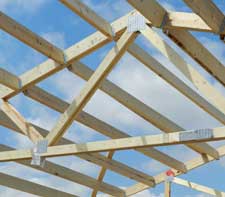Truss Bracing In The Way?
Thirty three years ago, when I first dipped a toe into the post frame industry, roof truss bracing was pretty much an afterthought. Even though I came to pole buildings from the prefabricated metal plated truss business, bracing (especially of bottom chords) was pretty much a subject left up to the person doing the building.
Back then, it was not unusual to see 40 foot and wider spans, with absolutely no bracing at all between pairs of trusses spaced every 10 to 14 feet.
Apply a bit of a load to those trusses, from either wind or snow, and the bottom chords begin to form an “S” curve, as they are buckling in the weak direction.
 Solution to the S? Add bracing.
Solution to the S? Add bracing.
Modern engineered prefabricated roof trusses do take into account and recommend bracing. Oddly, the drawings will specify what appears to be a single 2x lateral brace, on truss spacings greater than 10 feet. Why I say “odd” is because a single 2x brace, of any size, which spans over ten feet, will buckle in the weak direction just like the trusses did.
Roof truss bottom chord bracing, properly designed and installed will not only keep the trusses in plane (standing upright), but will also brace the endwall columns. By the use of strategically located X bracing, loads from the endwalls and truss bottom chords can be transferred into the roof diaphragm.
A “load path” must be created from one end of the building, to the opposite end.
For example: a 60 foot long building, with five equal sidewall column spacings (or bays) of 12 feet each. Bays one and five are braced with X’s from the end truss bottom chord to the top chord of the second pair of trusses; and from the end truss top chord to bottom chord of second pair of trusses. Common sense says this is a fairly rigid bracing system as both directions take the loads into the plane of the roof.
In bays two, three and four, lateral bottom chord bracing is applied in the plane of the bottom chords. This bracing is anchored to the relatively “stiff” first and fifth bays.
Let’s complicate matters….
Imagine bay #3 has a large door, through which building owner desires to drive a vehicle in, place on a car lift and raise it so it is between the pairs of trusses. Wonderful, until the vehicle hits the truss bracing.
Oops….
Solution: remove the lateral bottom chord bracing in bay #3 and change the bracing in Bays #2 and 4 to X bracing. Every truss is still braced in both directions, and the load between the second and third pairs of trusses is transferred by the roof diaphragm.
If the building is designed by a RDP (registered design professional – architect or engineer), it is essential this modification be ideally made in the initial bracing design, so as not to incur additional engineering fees for a change.
Obviously this solution will not work to remove lateral bottom chord bracing in adjacent bays, but it does afford some added flexibility in design solutions.






